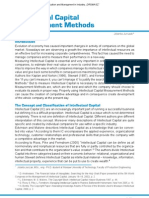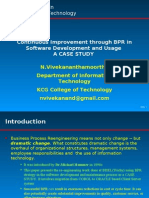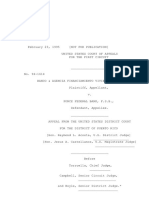What Is Technology Transfer
What Is Technology Transfer
Uploaded by
Shreya Saransh GoelCopyright:
Available Formats
What Is Technology Transfer
What Is Technology Transfer
Uploaded by
Shreya Saransh GoelOriginal Description:
Original Title
Copyright
Available Formats
Share this document
Did you find this document useful?
Is this content inappropriate?
Copyright:
Available Formats
What Is Technology Transfer
What Is Technology Transfer
Uploaded by
Shreya Saransh GoelCopyright:
Available Formats
What is technology transfer?
Technology transfer is the term used to describe the processes by which technological knowledge moves within or between organisations. International technology transfer refers to the way in which this occurs between countries. OR Technology Transfer also called Transfer of Technology (TOT) and Technology Commercialisation, is the process of transferring skills, knowledge, technologies, methods of manufacturing, samples of manufacturing and facilities among governments or universities and other institutions to ensure that scientific and technological developments are accessible to a wider range of users who can then further develop and exploit the technology into new products, processes, applications, materials or services. It is closely related to (and may arguably be considered a subset of) knowledge transfer. OR Technology Transfer is the process by which technology is disseminated. It involves communication of relevant knowledge by the Transferor to the Recipient. It is in the form of technology transfer transaction which way or may not be a legally binding
The economic view of technology transfer :
Information is the intrinsic core Technology is the exterior expression Practice Research Approach Information economics, Transaction cost Economics, Institutional Economics
Technology Transfer Activities include:
processing and evaluating invention disclosures; filing for patents; technology marketing; licensing; protecting intellectual property arising from research activity; and assisting in creating new businesses and promoting the success of existing firms. The result of these activities will be new products, more high-quality jobs, and an expanded economy.
Types of Technology Transfer :
Scientific Knowledge Transfer, Direct Technology Transfer, Spin-off Technology Transfer Informal Technology Transfer & Formal Technology Transfer : Internal Technology Transfer & External Technology Transfer :Internal Technology Transfer refer to such technology transfers / investments where control on the ownership & usage of technology resides with the transferor.
EXTERNAL In these transfers, control on the ownership & usage of technology usually does not remain with transferor and it passes on to the recipient, like joint venture with local control, licensing agreement etc. Technology transfer crossing industries.:- U.S. Department of defense 1980 Stevenson-Wydler technology innovation act 1986 technology transfer act 1989 national competitiveness & technology transfer act E.g., the 2G CDMA mobile technology International technology transfer: The goose-fleet patternthe
international technology transfer from U.S. to Japan, and then retransfer to four Asia Tigers, and Thailand, Indonesia, Malaysia, China, Vietanam, etc. (the TLC model for international technology
transfer according to the cost of factors)
Modes of Payment for Technology Transfer :
Lump sum payment or periodical instalments
Royalities as a %age of sales over next few years Cross-licensing agreements Contracted supply of output Issue of equity shares in lieu of technology transferred
Ways Technology is Transferred
Consulting Graduating students (moving heads) Faculty moving on (moving heads) Collaborative research Patenting and licensing Service and outreach (extension) Spin-off companies
Technology Transfer Agents:
Constituents of Technology Transfer Processes
Technology Transfer Technology Promotion Technology Deployment Technology Innovation
Technology Development Technology Research Technology Assessment Technology Information and communication Technology Investment Technology Collaboration Technology Commercialization
Tech-Transfer Process
There is a strong need for linkages to be developed and maintained between industry and research organizations. This requires the effective identification and specification of research needs, and knowledge of relevant research that is being conducted. For this to happen, industry needs to be involved at an early stage of research, so as to be able to participate even in the research definition stage. At the same time, public sector research organizations need to be prepared to support industry in the commercialization process. Efforts to
erase preconceptions that build barriers to successful technology transfer should also be taken.
Proper Research By proper research we mean firstly that in which the result are reproducible and issues such as scale up, stability etc and other practical now has been addressed, also that in which problem were taken up in first place
Proper work- This refer to institutional and guidelines regarding IP Protection licensing modalities etc. which must be in place beforehand. In the absence of these, decision get delayed, lack of fairness in decision e.g. case of X institute, which came up with good technology but since no guidance were there, kept running around for two years and then gave up.
Pricing most difficult and critical area of Transfer of technology. - Too high price can put off buyer, leaving the technology unsold. - Too price a result in revenue loss. - There are basically two model regarding pricing 1) Price charged for a technology should depend upon market force i.e. impact of the technology irrespective of amount spent on developing it. 2) Price charged should include all expenses involved in developing it. Publicity It is important to identify and then approach buyer i.e. adopt targeted Publicity and not blanket publicity. Specific journal, website, letters to manufacturer, personal selective visit etc. are some common approach which help in locating buyer. Partnership this means working along with industry. Industry takes it up, manufacturer and makes available to society. Partnership are important to ensure your technology is successfully adopted simply conveying the details may not be sufficient. Peoples Acceptance It is no use trying to develop a technology which people will not accept e.g. due to religious reason/social concern etc. genetically modified food, irradiated vegetables processed beef in IndiA improved capsule made of non-vegetarian material.
Users/beneficiaries of Technology Transfer:
* technology transfer agents who are responsible for the search, adaptation or translation, packaging and dissemination, training and ensurement that a new; * technology is properly implemented, accepted and used to its full potential by a target user; * individuals responsible for technology transfer functions; * individuals charged with the responsibility of making decisions as to whether a technology is considered for implementation within the organization; * individuals charged with budgeting responsibilities which encompass evaluating the cost of new technology; * individuals charged with strategic and business planning responsibilities within the organization; * individuals who are being trained to perform any of the above noted functions; * inventors, vendors, licensors and purchasers of technology.
Some issues/themes in Technology Transfer:
Basic Understanding Of Technology Transfer * What is Technology Transfer? * Overview of Technology Transfer Legislation * The Who of technology Transfer * Technology Transfer Related Organizations Hows and Whys of Technology Transfer * Types of Technology Transfer * What Drives Technology Transfer? * Main Modes of Technology Transfer * Benefits and Risks of Technology Transfer Intellectual Property Issues * Forms of Intellectual Property * Overview of Patents and Copyrights * Trademarks and Trade Secrets * Owning and Protecting Intellectual Property Technology Transfer Mechanisms * Overview of TT Mechanisms * License Agreements * Government Funded Programs * Grants and Cooperative Agreement
You might also like
- Brother RGG CEDocument3 pagesBrother RGG CEk.7330167No ratings yet
- Course: Business: Concepts and Prototypes - Fall 2021Document12 pagesCourse: Business: Concepts and Prototypes - Fall 2021Vanessa AkhtarNo ratings yet
- Technology Transfer Protocol of The DOST Research and Development InstitutesDocument14 pagesTechnology Transfer Protocol of The DOST Research and Development InstitutesDee Comon100% (1)
- Startup's EcosystemDocument3 pagesStartup's Ecosystemnekia19100% (1)
- Intellectual Property: From Creation to Commercialisation: A Practical Guide for Innovators & ResearchersFrom EverandIntellectual Property: From Creation to Commercialisation: A Practical Guide for Innovators & ResearchersNo ratings yet
- Apple Inc. Swot Analysis 2017Document28 pagesApple Inc. Swot Analysis 2017Augusto Teixeira Modesto100% (1)
- Question 6 (5 Points - Max 150 Words) : Grading CriteriaDocument3 pagesQuestion 6 (5 Points - Max 150 Words) : Grading CriteriaroyNo ratings yet
- Ohio Homeland Security Hls 0075 A Guide To Somali CultureDocument44 pagesOhio Homeland Security Hls 0075 A Guide To Somali CultureSFLD0% (1)
- Final Proposal MyagdiDocument16 pagesFinal Proposal MyagdiPrajiban Pradhan100% (1)
- Technology TransferDocument22 pagesTechnology TransferRohith C Balachandran100% (1)
- Unit Iv: Technology TransferDocument34 pagesUnit Iv: Technology Transferswathi krishnaNo ratings yet
- Unit 8 Commercialization (FINAL VERSION)Document38 pagesUnit 8 Commercialization (FINAL VERSION)FatthulHadiNo ratings yet
- Technology Transfer - 07 PDFDocument54 pagesTechnology Transfer - 07 PDFFayas AhamedNo ratings yet
- Importance of Technology TransferDocument6 pagesImportance of Technology Transfereongoren80% (10)
- Technology TransferDocument1 pageTechnology Transferdpka85No ratings yet
- Freedom To Operate Search-Dr NidhiDocument24 pagesFreedom To Operate Search-Dr Nidhisandeep patialNo ratings yet
- Role of MNC's in Transfering TechnologyDocument42 pagesRole of MNC's in Transfering TechnologyOsman Gani100% (3)
- Introduction To Patent Map Analysis2011Document50 pagesIntroduction To Patent Map Analysis2011Ngọc Quyền PhạmNo ratings yet
- 8 Steps of Tech CommercializationDocument1 page8 Steps of Tech CommercializationshekharcNo ratings yet
- Technology Valuation ModelDocument16 pagesTechnology Valuation ModelAjayktrNo ratings yet
- Technology Transfer MethodsDocument7 pagesTechnology Transfer MethodsM Jameel MydeenNo ratings yet
- Innovation: History of Innovation in BusinessDocument13 pagesInnovation: History of Innovation in Businessosbornenterprise100% (2)
- Technology Transfer ProcessDocument1 pageTechnology Transfer ProcessdikpalakNo ratings yet
- Intellectual PropertyDocument11 pagesIntellectual PropertyZEBA YASMINNo ratings yet
- IP Due Diligence For Angel InvestorsDocument6 pagesIP Due Diligence For Angel InvestorsJay CreutzNo ratings yet
- Unit 7 Intellectual PropertyDocument49 pagesUnit 7 Intellectual PropertyZulaikha ZulaikhaNo ratings yet
- Diffusion of Innovations Theory RogersDocument5 pagesDiffusion of Innovations Theory RogersIqbal FathurrahmanNo ratings yet
- Research and Development For InnovationDocument167 pagesResearch and Development For InnovationMarketing Media TodayNo ratings yet
- Contemporary Issues in MarketingDocument11 pagesContemporary Issues in MarketingRahul PawarNo ratings yet
- Summer Purchasing Internship ReportDocument27 pagesSummer Purchasing Internship ReportRaunak JainNo ratings yet
- Intellectual Capital Measurement MethodsDocument9 pagesIntellectual Capital Measurement MethodsLuciana Nagel-PiciorusNo ratings yet
- Rocking The Daisies - 2011 & 2012 - Case StudyDocument6 pagesRocking The Daisies - 2011 & 2012 - Case StudyPooja ShettyNo ratings yet
- Intellectual Property Management - Oxford Bussiness SchoolDocument48 pagesIntellectual Property Management - Oxford Bussiness SchoolAlexandre BarcellosNo ratings yet
- Process of Technology ChangeDocument78 pagesProcess of Technology ChangeAbhishek SayshuttleNo ratings yet
- Template For Research ProposalDocument16 pagesTemplate For Research ProposalJanus Raymond TanNo ratings yet
- Intellectual Property - LebretDocument50 pagesIntellectual Property - LebretHerve LebretNo ratings yet
- Open Source Vs SaaSDocument13 pagesOpen Source Vs SaaSSujitNo ratings yet
- 458490main TRL DefinitionsDocument1 page458490main TRL DefinitionsWoofyNo ratings yet
- Huawei FinalDocument10 pagesHuawei FinalMohitosh Negandhi100% (1)
- Technology Transfer & FDIDocument21 pagesTechnology Transfer & FDIAjayktrNo ratings yet
- The Globalisation of Indian CompaniesDocument28 pagesThe Globalisation of Indian Companiesutkarsh44100% (1)
- Entrepreneur TestDocument8 pagesEntrepreneur TestAriful RussellNo ratings yet
- BPR Case StudyDocument32 pagesBPR Case StudyN.Vivekananthamoorthy0% (1)
- 28588-Wood PPTsDocument99 pages28588-Wood PPTsIsanka P GamageNo ratings yet
- Entrepreneurship Toolkit - Baker Library - Harvard Business SchoolDocument4 pagesEntrepreneurship Toolkit - Baker Library - Harvard Business SchoolcmkkaranNo ratings yet
- InnovationDocument7 pagesInnovationZain LakdawalaNo ratings yet
- Turnitin - Doc DissertationDocument54 pagesTurnitin - Doc DissertationElizabeth Karua100% (1)
- Assignment Two: Employability Tool KitDocument24 pagesAssignment Two: Employability Tool KitAaron Iron TsakaNo ratings yet
- Business Development Plan - editedREVDocument18 pagesBusiness Development Plan - editedREVWilliamArugaNo ratings yet
- Government Digital Transformation A Complete Guide - 2020 EditionFrom EverandGovernment Digital Transformation A Complete Guide - 2020 EditionNo ratings yet
- The Social Science of Entrepreneurship - Syllabus - Stanford 2008Document26 pagesThe Social Science of Entrepreneurship - Syllabus - Stanford 2008Josh ConstineNo ratings yet
- Audience Recognition and InvolvementDocument19 pagesAudience Recognition and InvolvementMuhammadJamshaidIqbalNo ratings yet
- Incremental Vs Radical InnovationDocument4 pagesIncremental Vs Radical InnovationAkhil Vigh100% (2)
- Web 3.0Document14 pagesWeb 3.0GV PrabakaranNo ratings yet
- Recommendation SystemDocument7 pagesRecommendation SystemMuhammed ShabilNo ratings yet
- Effects of Choice of Country On The Success of Accelerator-Based Technology Startups: A Comparison of Ireland and SpainDocument103 pagesEffects of Choice of Country On The Success of Accelerator-Based Technology Startups: A Comparison of Ireland and SpainAmado HidalgoNo ratings yet
- Social Media and Entrepreneurship Research - A Literature ReviewDocument21 pagesSocial Media and Entrepreneurship Research - A Literature ReviewUmialqyNo ratings yet
- On Currency ConvertibilityDocument19 pagesOn Currency ConvertibilityShreya Saransh Goel100% (1)
- Organizational Change and Stress Management: Chapter 18 OutlineDocument15 pagesOrganizational Change and Stress Management: Chapter 18 OutlineShreya Saransh GoelNo ratings yet
- (Recruitment Process of Bajaj Allianz For Sales Cader) : Seminar Report ONDocument40 pages(Recruitment Process of Bajaj Allianz For Sales Cader) : Seminar Report ONShreya Saransh GoelNo ratings yet
- On Junk FoodDocument23 pagesOn Junk FoodShreya Saransh GoelNo ratings yet
- On FeedbackDocument14 pagesOn FeedbackShreya Saransh Goel100% (1)
- On Mind ManagementDocument8 pagesOn Mind ManagementShreya Saransh GoelNo ratings yet
- Corporate Level StrategiesDocument37 pagesCorporate Level StrategiesShreya Saransh GoelNo ratings yet
- On LawDocument26 pagesOn LawShreya Saransh GoelNo ratings yet
- Ms-62 Sales ManagementDocument43 pagesMs-62 Sales ManagementShreya Saransh GoelNo ratings yet
- North American Free Trade Agreement (Nafta) & International Monetary Fund (IMF)Document17 pagesNorth American Free Trade Agreement (Nafta) & International Monetary Fund (IMF)Shreya Saransh GoelNo ratings yet
- Sales Management: Bachelor of Business Administration (B.B.A.)Document202 pagesSales Management: Bachelor of Business Administration (B.B.A.)Shreya Saransh GoelNo ratings yet
- Foreign InvestmentDocument19 pagesForeign InvestmentShreya Saransh GoelNo ratings yet
- On LPGDocument24 pagesOn LPGShreya Saransh GoelNo ratings yet
- Industrial PollutionDocument16 pagesIndustrial PollutionShreya Saransh GoelNo ratings yet
- Sales ManagementDocument55 pagesSales ManagementShreya Saransh GoelNo ratings yet
- Banco & Agencia v. Ponce Federal, 1st Cir. (1995)Document18 pagesBanco & Agencia v. Ponce Federal, 1st Cir. (1995)Scribd Government DocsNo ratings yet
- Mitchell v. LathDocument2 pagesMitchell v. Lathcrlstinaaa100% (2)
- United States Court of Appeals Second Circuit.: No. 39. No. 175. Docket 24376. Docket 24848Document3 pagesUnited States Court of Appeals Second Circuit.: No. 39. No. 175. Docket 24376. Docket 24848Scribd Government DocsNo ratings yet
- Extintores Badger Certificacion Ul Polvo Quimico Seco PDFDocument3 pagesExtintores Badger Certificacion Ul Polvo Quimico Seco PDFEliud RodriguezNo ratings yet
- Future Challenges of Cultivating Oil Palm in Peat: March 2022Document15 pagesFuture Challenges of Cultivating Oil Palm in Peat: March 2022lester wollisNo ratings yet
- Payment of Bonus Act FormsDocument5 pagesPayment of Bonus Act Formspratik06No ratings yet
- Intricacies of Revenge Porn: An Analysis of Legal Provisions by DR Sandeep MishraDocument15 pagesIntricacies of Revenge Porn: An Analysis of Legal Provisions by DR Sandeep MishraPrayagraj Law ReviewNo ratings yet
- Gospel of JohnDocument4 pagesGospel of JohnBavly KostNo ratings yet
- Good Citizenship Values 1Document22 pagesGood Citizenship Values 1asdwasdwaNo ratings yet
- Gallanosa v. Arcangel DigestDocument2 pagesGallanosa v. Arcangel DigestDean Lozarie100% (1)
- Salaam Namaste (90.4) : AboutDocument4 pagesSalaam Namaste (90.4) : AboutAyush DixitNo ratings yet
- 0 - Zone Brewery Support Handbook v02 2017Document130 pages0 - Zone Brewery Support Handbook v02 2017edward contrerasNo ratings yet
- Email CoalitionDocument2 pagesEmail CoalitionJual IGNo ratings yet
- Department of Labor: 022504EDIpresentationDocument137 pagesDepartment of Labor: 022504EDIpresentationUSA_DepartmentOfLaborNo ratings yet
- DraculaDocument2 pagesDraculajoancanalNo ratings yet
- Pharmaco Distribution V Weideman PDFDocument26 pagesPharmaco Distribution V Weideman PDFTiso Blackstar GroupNo ratings yet
- Soal Latihan Bahasa Inggris Kelas 2Document3 pagesSoal Latihan Bahasa Inggris Kelas 2Dash Da Gomez0% (2)
- UCSP Quarter 2 Reviewer 1Document8 pagesUCSP Quarter 2 Reviewer 1Je-Ann Legarde ElevazoNo ratings yet
- Makers of Modern Korean BuddhismDocument395 pagesMakers of Modern Korean BuddhismcyberbiopunkNo ratings yet
- Rosa Bonheur PDFDocument10 pagesRosa Bonheur PDFIolandaTomiucNo ratings yet
- Scan 22 Oct 24 20 35 30Document1 pageScan 22 Oct 24 20 35 30macariomauromNo ratings yet
- Introduction To Bpo: F.Y. Bcom - Banking and Insurance 1Document29 pagesIntroduction To Bpo: F.Y. Bcom - Banking and Insurance 1Mitali MehtaNo ratings yet
- RiffsDocument31 pagesRiffsmatheusgadelha253No ratings yet
- ACR FORM (For The Officials From BPS 7 To BPS 16) - FinalDocument5 pagesACR FORM (For The Officials From BPS 7 To BPS 16) - Finalramchandani ravi ramchandani raviNo ratings yet
- Section D. Writing (6.0 Points) : The New MusicDocument3 pagesSection D. Writing (6.0 Points) : The New MusicNgân LêNo ratings yet
- Advanced Unit Test 4: Grammar VocabularyDocument2 pagesAdvanced Unit Test 4: Grammar VocabularyAlinaNo ratings yet
- A Study On Provision of Legal Assistance To The Poor in IndiaDocument18 pagesA Study On Provision of Legal Assistance To The Poor in IndiaAnshu SharmaNo ratings yet








































































































